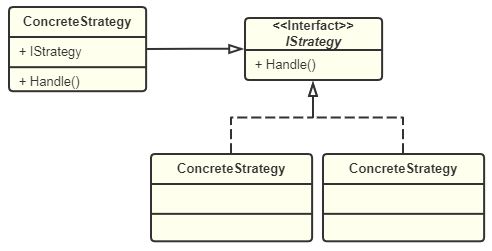在策略模式中,一个类的行为或算法可以在运行时动态更改。
GOF对策略模式的描述为:
Define a family of algorithms, encapsulate each one, and make them interchangeable. Strategy lets the algorithm vary independently from clients.
— Design Patterns : Elements of Reusable Object-Oriented Software
UML类图如下:

策略模式包含三个角色:
- Context上下文角色,起承上启下封装作用,屏蔽高层模块对策略、算法的直接访问,封装可能存在的变化。
- Strategy抽象策略角色,策略、算法家族的抽象,通常为接口,定义每个策略或算法必须具有的方法和属性。
- ConcreteStrategy具体策略角色,实现抽象策略中的操作,该类含有具体的算法。
代码示例:
以电商会员折扣为例,不同级别的会员享受的折扣是不同的,这种差异可以用策略模式来封装。
public interface Strategy
{
double CalcPrice(double originalPrice);
}
public class PrimaryStrategy : Strategy
{
public double CalcPrice(double originalPrice)
{
return originalPrice;
}
}
public class IntermediateStrategy : Strategy
{
public double CalcPrice(double originalPrice)
{
return originalPrice * 0.9;
}
}
public class AdvancedStrategy : Strategy
{
public double CalcPrice(double originalPrice)
{
return originalPrice * 0.8;
}
}
public class PriceContext
{
public Strategy Strategy { get; set; }
public double GetPrice(double originalPrice)
{
return this.Strategy.CalcPrice(originalPrice);
}
}
调用端:
public class Test
{
public static void Entry()
{
Strategy strategy = new PrimaryStrategy();
PriceContext price = new PriceContext();
price.Strategy = strategy;
Console.WriteLine(price.GetPrice(100)); //100
strategy = new IntermediateStrategy();
price.Strategy = strategy;
Console.WriteLine(price.GetPrice(100)); //90
strategy = new AdvancedStrategy();
price.Strategy = strategy;
Console.WriteLine(price.GetPrice(100)); //80
}
}
示例中有若干具体的策略类,以及一个context对象,context对象会随着策略对象的改变而变更其执行算法。
策略模式的优点
- 算法可以自由切换,只要实现抽象策略,它就成为策略家族的一个成员,通过封装角色对其进行封装,保证对外提供“可自由切换”的策略。
- 避免使用多重条件判断,多重条件语句不易维护,而且出错的概率较大。使用策略模式后,可以由其他模块决定采用何种策略,策略家族对外提供的访问接口就是封装类,简化了操作,同时避免了条件语句判断。
- 扩展性良好,在现有的系统中增加一个策略非常容易,只要实现接口就可以了。
策略模式的缺点
- 策略类数量增多,每一个策略都是一个类,复用的可能性很小,类数量增多。
- 所有的策略类都需要对外暴露,上层模块必须知道有哪些策略,并了解这些策略之间的区别,然后才能决定使用哪一个策略,这与迪米特法则是相违背的。
策略模式的适用场景
- 多个类只有在算法或行为上稍有不同的场景。
- 算法需要自由切换的场景。